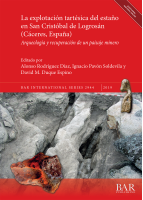Description
Este libro reúne las investigaciones sobre la explotación tartésica del estaño realizadas en San Cristóbal de Logrosán (Cáceres, España) por Craig Merideth entre 1992 y 2002 y las coordinadas por el G.I. PRETAGU de la Universidad de Extremadura entre 2013 y 2017. En síntesis, se trata de un estudio interdisciplinar sobre este poblado minero-metalúrgico y de la comunidad que lo habitó, incluida una propuesta de la ‘cadena operativa’ del beneficio de la casiterita durante el Bronce Final-Hierro I. El relevante papel jugado por este estratégico recurso parece justificar la presencia en esta region interior del suroeste ibérico de elementos de prestigio y estatus social como los del Tesoro de Berzocana y la estela de guerrero de Solana de Cabañas. A mayor escala, los estudios arqueológicos y analíticos permiten integrar San Cristóbal en la ‘red regional’ de contactos e intercambios atlántico-mediterráneos confluyentes en Huelva, foco emergente de Tartessos.
This book brings together the archaeological research carried out by Craig Merideth between 1992 and 2002 on the Tartessian exploitation of tin in Cerro de San Cristóbal de Logrosán (Cáceres, Spain) and the work done later, in the period 2013-2017, coordinated by the G.I. PRETAGU of the University of Extremadura. It is an interdisciplinary study of this metallurgical-mining site and the community that settled there, including a proposal of the ‘operational chain’ of the treatment and use of the cassiterite during the Late Bronze-Iron I phase. The relevant role played by this strategic mineral resource seems to justify the presence of elements of prestige and social status such as the Berzocana Treasure and the warrior’s stela of Solana de Cabañas in the south-central west of the Iberian Peninsular. On a larger scale, archaeological and analytical studies allow the integration of San Cristóbal into the ‘regional network’ of Atlantic-Mediterranean contacts and exchanges converging in Huelva, an emerging settlement of Tartessos.
AUTHOR
Alonso Rodríguez Díaz es catedrático de Prehistoria en la Universidad de Extremadura, buen conocedor de las culturas protohistóricas en el suroeste de la peninsula ibérica.
Ignacio Pavón Soldevila es profesor titular de Prehistoria en la Universidad de Extremadura e investigador de la Edad del Bronce y la Edad del Hierro en el suroeste de la peninsula ibérica.
David M. Duque Espino es investigador contratado doctor de Prehistoria en la Universidad de Extremadura y especialista en antracología pre- y protohistórica de la peninsula ibérica.
Autores y colaboradores:Ester Boixereu i Vila, Antonio Caño Mudarra, Arturo Domínguez García, M.ª Paz Dorado Martínez, David M. Duque Espino, David García Alonso, M.ª Dolores Hernández Corbalán, Mark A. Hunt Ortiz, José Manuel Márquez Gallardo, Francisco Márquez García, José Miguel Mirón Rodríguez, Ignacio Pavón Soldevila, Alonso Rodríguez Díaz, Jairo Serrano Guerrero, Francisco María Vázquez Pardo, Jacobo Vázquez Paz.
REVIEWS
‘This study dares for the first time to analyse exhaustively one of the great centres of exploitation of tin at the end of Prehistory … The other large tin deposits of the ancient world (Iran, Britain, SW England) have never been analysed from this archaeological and archaeo-metallurgical perspective.’ Prof. María Eugenia Aubet, Universidad Pompeu Fabra, Barcelona
‘The data from this excavation will contribute to a better understanding of the historical dynamics in the south-central west of the Iberian Peninsula, during the Bronze Age and the beginning of the Iron Age.’ Dr María Jesús de Pedro Michó, Museu de Prehistòria de València
‘It is the first and, currently, the only detailed excavated and published site about tin exploitation during the Bronze Age, so it constitutes a reference for future work.’ Peer Reviewer











